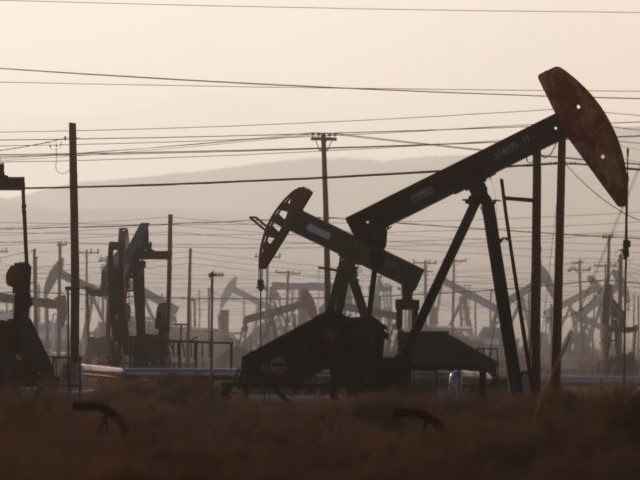Since day one, President Joe Biden has made crippling the fossil fuel industry a priority, from shutting down the Keystone Pipeline — one of his first actions after taking office — to halting energy exploration on federal land.
The federal government owns roughly 640 million acres, about 28 percent of the 2.27 billion acres of land in the United States, according to the Congressional Research Service — and that includes large swaths of a number of western states with economies that rely on the fossil fuel sector.
And when oil supplies started to fall, Biden looked abroad before circling back to domestic sources that before his election had made the U.S. energy independent.
“First came a trip to Riyadh for Jake Sullivan, Biden’s national security adviser, where he asked Saudi Arabia to increase production,” the Financial Times reported:
Then Jennifer Granholm, Biden’s energy secretary, told the Financial Times in October that the U.S. was considering a price-sapping release of crude from its strategic stockpiles. The White House even contacted some U.S. oil producers to ask how quickly they could bump up output — an awkward move for an administration that many oil executives consider hostile to their sector.
Biden even vaguely threatened Russia and Saudi Arabia on the eve of the United Nation’s COP26 climate summit if they didn’t increase oil production.
“What we’re considering doing on that, I’m reluctant to say before I have to do it,” Biden told reporters.
The Financial Times reported:
The open-ended threat will have given the Opec+ oil exporter group something else to ponder when it meets today to decide whether to adjust its production quotas. Most Opec watchers think the group will stick with its existing plan, which is to add 400,000 barrels a day of supply each month as it restores the huge swath of production it agreed — under US pressure — to cut last year to lift prices. If so, it will be a disappointment to Biden. The president is right to be worried, say industry analysts and investors. Oil prices, already above $80 a barrel, are at their highest level in seven years. While soaring natural gas prices in Europe and Asia have sparked alarm, the oil rally is gathering the kind of momentum that some believe could culminate in an economy-draining spike like that seen in 2008, when prices hit almost $150 a barrel just before the global financial crisis. No one believes this short-term price surge — dubbed a “final hurrah” by some executives — will solve the problems facing the oil sector.
A year away from midterm elections, the danger of further oil price inflation for Biden is plain. A gallon of petrol in the US now costs on average $3.40, according to the AAA motoring group — half the price a consumer in the UK might pay, but 60 per cent more than during the final months of the presidency of Donald Trump. Stickers of a pointing Biden, declaring, “I did that”, are available on Amazon.com and have, in recent weeks, begun appearing next to the price ticker on forecourt pumps. Biden’s Republican opponents have seized on rising petrol prices to argue that his energy policies are penalising Americans already squeezed by supply chain chaos.
As the air quality in cities improved last year, a seductive notion emerged: that pandemic lockdowns had helped cure the world of its oil addiction. Governments could now “build back better”, accelerating a clean green pivot to the lower-carbon economy and making strides in the effort to halt climate change. The notion, at least in terms of demand, has proved shortlived. Stimulus spending and months of cheap oil prices sparked a revival in consumption at a pace almost as stunning as the drop had been during the pandemic collapse. Between the second quarters of 2020 and 2021, global oil consumption rose by 12m b/d, according to the IEA, an unprecedented surge.
The Financial Times reported that demand for oil in the U.S. in the past month was just shy of 21 million barrels a day, only 2 percent less than the same period two years ago.
And “oil company coffers are bursting with cash again. Last week, less than 24 hours after Darren Woods, ExxonMobil’s chief executive, and his Chevron counterpart Michael Wirth appeared in Congress for a grilling about climate disinformation, their companies reported bumper quarterly profits and juicy share buybacks,” the Times reported.
Chevron and ExxonMobile are already both operating more rigs than last year in the Permian Basin of New Mexico and Texas and the U.S.
And although data from trip planning on Apple shows that usage of public transport have not reached their pre-pandemic level, in many big cities cars are not only back but above the norm. And air travel is on the rise.
As a result, the oil will likely keep flowing.
“We’ve all decided that we want to stop investing in oil supply,” Ben Dell, head of Kimmeridge, a private equity investor, said in the Times report. “But nobody told the consumer.”
Follow Penny Starr on Twitter or send news tips to pstarr@breitbart.com.

COMMENTS
Please let us know if you're having issues with commenting.